Related Research Articles

The House of Medici was an Italian banking family and political dynasty that first consolidated power in the Republic of Florence under Cosimo de' Medici during the first half of the 15th century. The family originated in the Mugello region of Tuscany, and prospered gradually until it was able to fund the Medici Bank. This bank was the largest in Europe during the 15th century and facilitated the Medicis' rise to political power in Florence, although they officially remained citizens rather than monarchs until the 16th century.
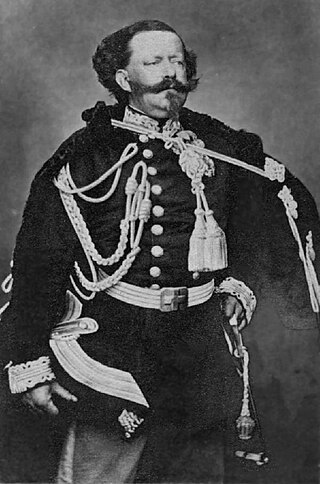
Victor Emmanuel II was King of Sardinia from 23 March 1849 until 17 March 1861, when he assumed the title of King of Italy and became the first king of an independent, united Italy since the 6th century, a title he held until his death in 1878. Borrowing from the old Latin title Pater Patriae of the Roman emperors, the Italians gave him the epithet of Father of the Fatherland.

Ferdinand III was Grand Duke of Tuscany from 1790 to 1801 and, after a period of disenfranchisement, again from 1814 to 1824. He was also the Prince-elector and Grand Duke of Salzburg (1803–1805) and Duke and Elector of Würzburg (1805–1814).

Leopold II was the Holy Roman Emperor, as well as King of Hungary, Croatia and Bohemia, and Archduke of Austria from 1790 to 1792, and Grand Duke of Tuscany from 1765 to 1790. He was a son of Empress Maria Theresa and Emperor Francis I, and the brother of Queen Marie Antoinette of France, Queen Maria Carolina, Duchess Maria Amalia of Parma, and Emperor Joseph II. Leopold was a moderate proponent of enlightened absolutism. He granted the Academy of Georgofili his protection. Unusually for his time, he opposed the death penalty and torture and abolished it in Tuscany on 30 November 1786 during his rule there, making it the first nation in modern history to do so. This act has been commemorated since 2000 by a regional custom known as the Feast of Tuscany, held every 30 November. Despite his brief reign, he is highly regarded. The historian Paul W. Schroeder called him "one of the most shrewd and sensible monarchs ever to wear a crown".

Ferdinand II was King of the Two Sicilies from 1830 until his death in 1859.
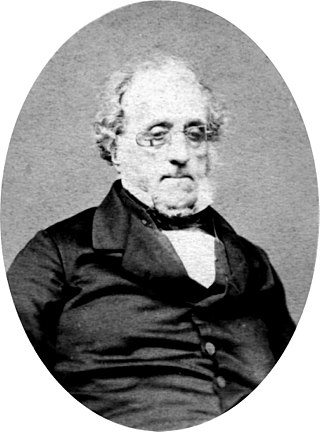
Marquis Gino Capponi was an Italian statesman and historian of a Liberal Catholic bent.
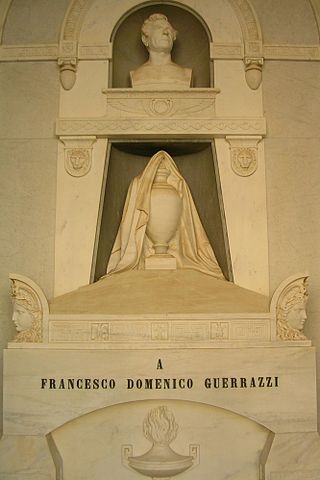
Francesco Domenico Guerrazzi was an Italian writer and politician involved in the Italian Risorgimento.
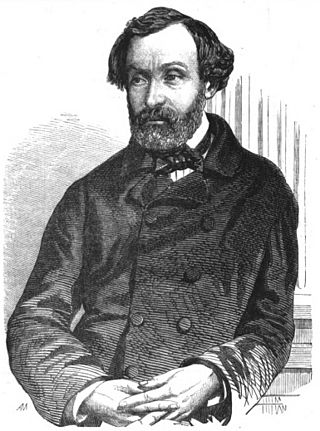
Giuseppe Montanelli was an Italian statesman and author.
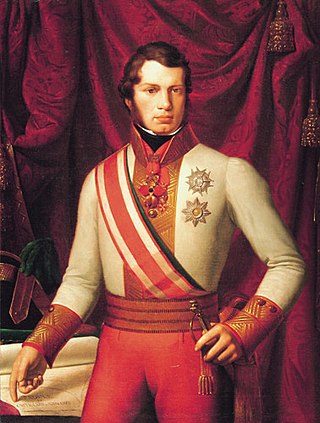
Leopold II was Grand Duke of Tuscany from 1824 to 1859. He married twice; first to Maria Anna of Saxony, and after her death in 1832, to Maria Antonia of the Two-Sicilies. By the latter, he begat his eventual successor, Ferdinand. Leopold was recognised contemporarily as a liberal monarch, authorising the Tuscan Constitution of 1848, and allowing a degree of press freedom.

Francis I of the Two Sicilies was King of the Two Sicilies from 1825 to 1830 and regent of the Kingdom of Sicily from 1806 to 1814.

Vincenzo da Filicaja was an italian poet and politician, citizen of Grand Duchy of Tuscany. His poetry was compared to that of Petrarch, and his association with the Accademia della Crusca gave him access to royal patronage. He served as governor of Volterra and Pisa, successively, and finally in the Tuscan Senate.

The Grand Duchy of Tuscany was an Italian monarchy that existed, with interruptions, from 1569 to 1860, replacing the Republic of Florence. The grand duchy's capital was Florence. In the 19th century the population of the Grand Duchy was about 1,815,000 inhabitants.
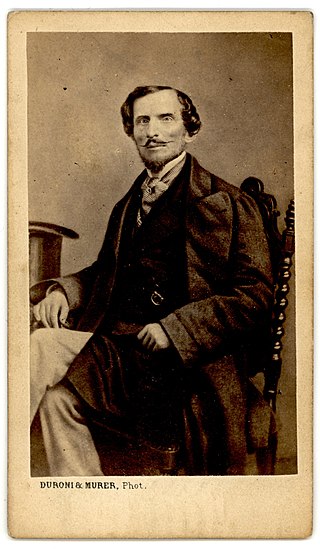
Bettino Ricasoli, 1st Count of Brolio, 2nd Baron Ricasoli was an Italian statesman. He was a central figure in the politics of Italy during and after the unification of Italy. He led the Moderate Party.
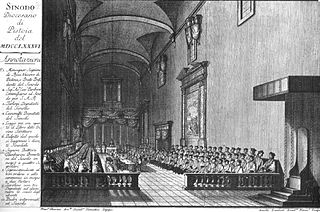
The Synod of Pistoia was a 1786 diocesan synod in the Catholic diocese of Pistoia, then part of the territory of the Grand Duchy of Tuscany. It was convoked by its bishop Scipione de' Ricci under the patronage and active support of the Habsburg-Lorraine Grand Duke Leopold. The synod adopted a series of decrees of Febronian or Gallican tendency, against the background of Enlightenment thinking. Leopold hoped the synod's resolutions would be taken up by a "national" council and increase state autocratic control over the Church in Tuscany. However, in 1787 the ensuing synod of bishops rejected the Pistoia decrees, and in 1794 Pope Pius VI condemned 85 of them, leading Ricci to recant.

Ferdinando I de' Medici, Grand Duke of Tuscany was Grand Duke of Tuscany from 1587 to 1609, having succeeded his older brother Francesco I, who presumably died from malaria.

Maria Maddalena of Austria was Grand Duchess of Tuscany by her marriage to Cosimo II in 1609 until his death in 1621. With him, she had eight children, including a duchess of Parma, a grand duke of Tuscany, and an archduchess of Further Austria. Born in Graz, Maria Magdalena was the youngest daughter of Charles II, Archduke of Inner Austria, and his wife Maria Anna of Bavaria. During the minority of her son, Grand Duke Ferdinando, she and her mother-in-law acted as regents from 1621 to 1628. She died on 1 November 1631 in Passau.
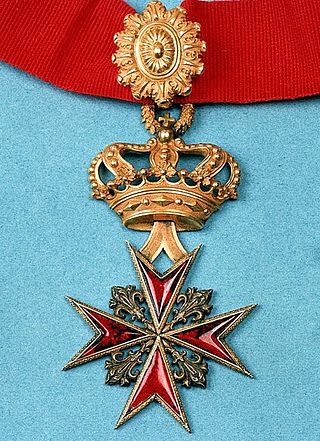
The Order of Saint Stephen is a Roman Catholic Tuscan dynastic military order founded in 1561. The order was created by Cosimo I de' Medici, first Grand Duke of Tuscany. The last member of the Medici dynasty to be a leader of the order was Gian Gastone de Medici in 1737. The order was permanently abolished in 1859 by the annexation of Tuscany to the Kingdom of Sardinia. The former Kingdom of Italy and the current Italian Republic also did not recognize the order as a legal entity but tolerates it as a private body.
The Tuscan Republic is the name often given to the brief period between February 1849 when Leopold II, Grand Duke of Tuscany fled Florence and April of the same year. In fact, although Tuscany had a provisional government with strong republican tendencies during this period, a republic was never officially proclaimed.

Antonio Mordini was a longstanding Italian patriot and, after 1861, a member of the Parliament of the Kingdom of Italy. In 1869 he served as Minister of Public Works of the Kingdom of Italy, a member of the third Menabrea government.
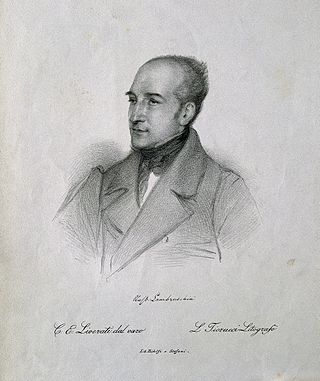
Raffaello Lambruschini was a priest, Tuscan agricultural and pedagogical scholar and author; and Italian politician and senator. His diverse interests were pursued through an evolving career.
References
Sources
- Chisholm, Hugh, ed. (1911). . Encyclopædia Britannica (11th ed.). Cambridge University Press.